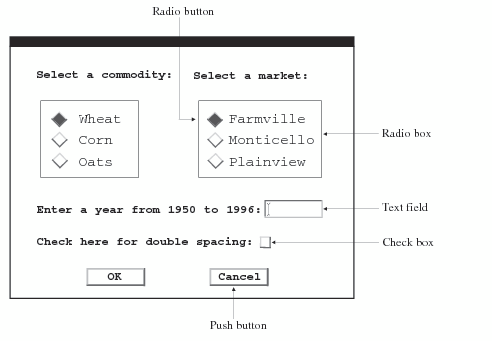PMENU Procedure
DIALOG Statement
Describes a dialog box that is associated with an
item on a menu.
| Restriction: | Must be followed by at least one TEXT statement. |
| Examples: | Collecting User Input in a Dialog Box |
Syntax
Required Arguments
- command-string
-
is the command or partial command that is executed when the item is selected. The limit of the command-string that results after the substitutions are made is the command-line limit for your operating environment. Typically, the command-line limit is approximately 80 characters.
- field-number-specification
-
can be one or more of the following:
@1…@n %1…%n &1…&n You can embed the field numbers, for example @1, %1, or &1, in the command string and mix different types of field numbers within a command string. The numeric portion of the field number corresponds to the relative position of TEXT, RADIOBOX, and CHECKBOX statements, not to any actual number in these statements.- @1…@n
-
are optional TEXT statement numbers that can add information to the command before it is submitted. Numbers preceded by an at sign (@) correspond to TEXT statements that use the LEN= option to define input fields.
- %1…%n
-
are optional RADIOBOX statement numbers that can add information to the command before it is submitted. Numbers preceded by a percent sign (%) correspond to RADIOBOX statements following the DIALOG statement.Note:Keep in mind that the numbers correspond to RADIOBOX statements, not to RBUTTON statements.
- &1…&n
-
are optional CHECKBOX statement numbers that can add information to the command before it is submitted. Numbers preceded by an ampersand (&) correspond to CHECKBOX statements following the DIALOG statement.
Note:To specify a literal @ (at sign), % (percent sign), or & (ampersand) in the command-string, use a double character: @@ (at signs), %% (percent signs), or && (ampersands).
Details
-
The following figure shows a typical dialog box. A dialog box can request information in three ways:Dialog boxes have two or more buttons, such as OK and Cancel, automatically built into the box.(footnote1) A button causes an action to occur.

